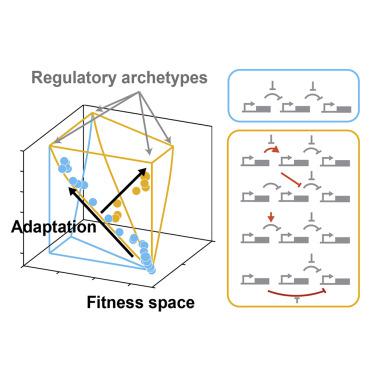Cell Systems ( IF 9.0 ) Pub Date : 2020-06-17 , DOI: 10.1016/j.cels.2020.05.004 Manjunatha Kogenaru 1 , Philippe Nghe 2 , Frank J Poelwijk 3 , Sander J Tans 4

|
Gene regulation networks allow organisms to adapt to diverse environmental niches. However, the constraints underlying the evolution of gene regulation remain ill defined. Here, we show that partial order—a concept that ranks network output levels as a function of different input signals—identifies such constraints. We tested our predictions by experimentally evolving an engineered signal-integrating network in multiple environments. We find that populations: (1) expand in fitness space along the Pareto-optimal front associated with conflicts in regulatory demands, by fine-tuning binding affinities within the network, and (2) expand beyond the Pareto-optimal front through changes in the network structure. Our constraint predictions are based only on partial order and do not require information on the network architecture or underlying genetics. Overall, our findings show that limited knowledge of current regulatory phenotypes can provide predictions on future evolutionary constraints.
中文翻译:

通过识别监管网络中的冲突需求来预测进化约束。
基因调控网络允许生物体适应不同的环境生态位。然而,基因调控进化的潜在约束条件仍然不明确。在这里,我们展示了偏序(一种将网络输出级别作为不同输入信号的函数进行排序的概念)可以识别此类约束。我们通过在多种环境中实验性地演化工程信号集成网络来测试我们的预测。我们发现种群:(1)通过微调网络内的绑定亲和力,沿着与监管需求冲突相关的帕累托最优前沿扩展适应空间,以及(2)通过改变网络结构。我们的约束预测仅基于偏序,不需要有关网络架构或基础遗传学的信息。










































 京公网安备 11010802027423号
京公网安备 11010802027423号